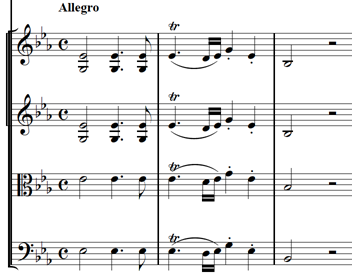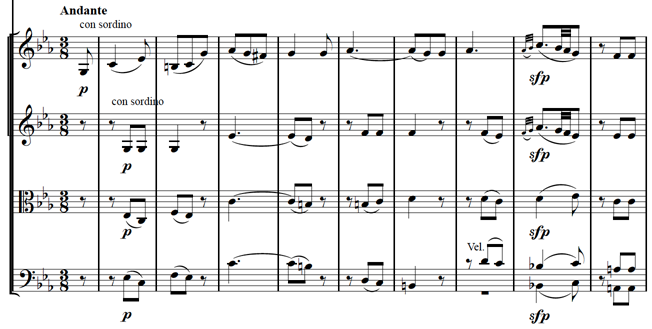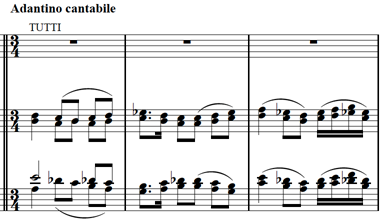Wolfgang Amadeus Mozart
Piano Concerto No.22 in E♭ major, K.482
Media Review / Comparison
2014-05-13 — Original posting (on Blogger)
2014-11-12 — Re-posting as is (WordPress)
2016-07-21 — Brushed up for better readability
Table of Contents
Introduction / The Recordings
This post was triggered by Kristian Bezuidenhout‘s new recording below, partially already covered in my “Listening Diary 2014-04-08” and “Mozart: Piano Concerto in G major, K.453“. Here are the recordings that I’m going to discuss in the case of K.482 (sorted by the pianist’s last name):
- Géza Anda, Camerata Academica des Salzburger Mozarteums (1962)
- Vladimir Ashkenazy, Philharmonia Orchestra (1978)
- Daniel Barenboim, English Chamber Orchestra (1971)
- Kristian Bezuidenhout, Petra Müllejans, Freiburger Barockorchester (2012)
About the Composition
The Piano Concerto No.22 in E♭ major, K.482 by Wolfgang Amadeus Mozart (1756 – 1791) is the last one that the composer wrote in 1785 — for himself. He first performed it as intermission piece in the performance of an oratorio by Carl Ditters von Dittersdorf, followed by an academy concert for subscribers, where according to his father he had to repeat the second movement (which his father felt to be rather unusual). Clearly, this concert is more virtuosic and brilliant than those written for Mozart’s pupils (e.g., K.453).
The Movements
Formally, the composition consists of three movements:
I. Allegro (4/4)
The first movement (381 bars, 4/4) is an Allegro, starting with the following main theme, played by the strings:
We don’t have any original cadenzas for this concerto, unfortunately.
II. Andante (3/8)
The second movement (213 bars, 3/8) is an Andante in C minor, with the following main theme, again played by the strings:
There is no provision for a cadenza in this movement.
III. Allegro (6/8) — Andantino cantabile (3/4) — Tempo I
The last movement (435 bars) starts with an Allegro part (217 bars, 6/8) with the following beginning played by the soloist:
The movement has a ternary A-B-A’ structure, the “B” section being an Andantino cantabile (47 bars, 3/4), starting with the theme in the woodwinds (clarinets, bassoons):
The final Tempo I part (171 bars) of this movement features a cadenza — again, no original cadenza by the composer is available (he most likely improvised the cadenza on the spot and saw no need to write it down).
Rating / Tempo Comparison Table
I have put together a little table, giving my (personal, relative) ratings (1 .. 5) and the metronome readings (approximate) for each movement & interpretation (blue indicating slower, green indicating faster performances):
For details see my comments below.
Comments on the Individual Recordings
Géza Anda
Mozart: The Piano Concertos
Géza Anda, Camerata Academica des Salzburger Mozarteums
DG 469510-2 (8 CDs, stereo); ℗ 1962 – 1971 / © 1995
booklet 37 pp., e/d/f

Recorded in 1962, Géza Anda (1921 – 1976) conducts the orchestra from the piano. This is part of a complete recording of all of Mozart’s piano concerti that I already had in my LP collection. Back in the LP days, this used to be my favorite recording (overall, at least). I now find that the quality of the orchestra is somewhat limited, and the sound of the recording (especially the piano) pretty dull.
Notes on the Movements
I. Allegro (4/4)
Duration: 13’00”; 1/4 = 130 (Allegro)
As one would expect for the oldest recording, the sound is more dull than with more recent interpretations. The woodwinds (esp. bassoon) are not always quite clean, and there are occasional (minor) coordination issues between solo and orchestra. the cadenza (Anda) is OK, classic, quite Mozartian, sounds appropriately improvised — though some of the material used sounds relatively “remote” / far-fetched.
II. Andante (3/8)
Duration: 9’41”; 1/8 = 62 (Andante)
Same tempo as Ashkenazy initially, but the strings sound rather “muddy”, the vibrato is too heavy. There is a slight tendency to accelerate towards the climax of a long phrase, which occasionally gives the impression of the tempo running away (in the C major part of the movement, the tempo is around 1/8 = 80). But the solo part and the woodwind solos are very expressive otherwise.
III. Allegro (6/8) — Andantino cantabile (3/4) — Tempo I
Duration: 11’18”; 3/8 = 108 (Allegro) — 1/4 = 56 (Andantino cantabile)
The tempo in the Allegro often feels rushed, there are occasional coordination issues in the orchestra, some of Anda’s ornaments are on the border of being superficial — but at least, the movement never boring. The Andantino cantabile is sweetish in the violins as well (as Barenboim’s and Ashkenazy’s), but that entire section isn’t, fortunately, thanks to a relatively lively tempo. [ Ha! my score — not a very reliable version, obviously — has “arco” in the right hand of the piano part, at bar 260! ] Anda’s own cadenza is a short, nice invention, at least melodically, and “fairly Mozartian” — but only rather remotely linked to the themes in this movement. Pretty entertaining in general, but rarely steps outside the conventional frame, except for the cadenza.
| Recommendation: | OK, in general. |
| Rating: | 3.0 (3 / 3 / 3) |
Vladimir Ashkenazy
Mozart: The Piano Concertos
Vladimir Ashkenazy, Philharmonia Orchestra
London Symphony Orchestra & others
London 443 727-2 (10 CDs, stereo); ℗ 1966 – 1988 / © 1970
booklet 54 pp., e/f/d/i

Recorded in 1978, Vladimir Ashkenazy (*1937) conducts the orchestra from the piano. Initially, when switching from LPs to CDs, I would look for versions that I did not already have on LP — and this was the one recording that I ran into at the time (at Tower Records in Mountain View, CA).
Notes on the Movements
I. Allegro (4/4)
Duration: 13’49”; 1/4 = 136 (Allegro)
The orchestra sound is more transparent than the English Chamber Orchestra with Barenboim, and the string sound is better / brighter, but the wind instruments (especially the woodwinds) are too weak, too much in the background. Ashkenazy articulates carefully at the piano — but is sometimes losing the drive. The cadenza (Ashkenazy) is OK, somewhat weird harmonically (within the classic style), and I doubt that Mozart (or any concert pianist at that time) would have used that much polyphony in a cadenza. In general, Ashkenazy’s playing / articulation is not very detailed, lacking intra-bar tension / “fine phrasing”.
II. Andante (3/8)
Duration: 10’12”; 1/8 = 62 (Andante)
Slightly faster than Barenboim, but still too slow, static overall, but at least, the articulation in the strings is lighter, so the vibrato doesn’t hurt that much, and the orchestra is well-balanced, overall (in the context of a traditional setting). The solo part is better, though: reasonably differentiated and articulated. Also, the woodwinds are played well and balanced against the strings and the solo; overall, though, the piano is a little overemphasized in this recording.
III. Allegro (6/8) — Andantino cantabile (3/4) — Tempo I
Duration: 12’44”; 3/8 = 96 (Allegro) — 1/4 = 50 (Andantino cantabile)
Often static, almost stiff, schematic — lacking the witty, joyful element. Ashkenazy adds a little cadenza (bigger than Barenboim’s) at the transition to the Andantino cantabile, and he fills the large intervals (e.g., in bars 164ff.) with arpeggiandi — but in general, he barely adds ornaments on his own. The Andantino cantabile is — as Barenboim’s — far too sweet in the strings, with a vast excess of vibrato. Both the cadenza leading back to the Allegro, as well as the “official” cadenza are somewhat strange, with odd (almost impressionist) harmonic turns — not an ideal fit. Also, the strings are often rather coarse in the Allegro, not subtle, really.
| Recommendation: | OK, but nothing special. |
| Rating: | 3.0 (3 / 3 / 3) |
Daniel Barenboim
Mozart: The Complete Piano Concertos
Daniel Barenboim, English Chamber Orchestra
EMI classics 5 72930 2 (10 CDs, stereo); ℗ 1967 – 1989 / © 1998
booklet 31 pp., e/d/f

Recorded in 1971, Daniel Barenboim (*1942) conducts the orchestra from the piano. This was one of the complete recordings of the Mozart piano concerti that I had on LP (besides Géza Anda and Ingrid Haebler).
Notes on the Movements
I. Allegro (4/4)
Duration: 13’09”; 1/4 = 136 (Allegro)
The orchestra is rather massive, the sound somewhat dull. In the exposition, there is a slight, but noticeable tempo jump — badly matching takes? The usual grand piano sound, not very differentiated. The cadenza (Barenboim) starts OK, but then moves on to be late classic, with some non-Mozartian harmonic moves — not the best fit, I think. The movement ends with a rather broad ritardando — there is none in the score.
II. Andante (3/8)
Duration: 10’10”; 1/8 = 56 (Andante)
Definitely too slow, overblown, with a rather obnoxious vibrato in strings and the flute, static overall, very (too) soft in the orchestra — the combination of extreme legato, slow vibrato, occasional portamento, and sordino result in an extremely “creamy” orchestra sound, and makes this sound like the soundtrack to a film — rather boring, overall; the piano is not accurate in the dynamics, and the left hand / accompaniment (many of the demisemiquaver figures) is often too loud / prominent.
III. Allegro (6/8) — Andantino cantabile (3/4) — Tempo I
Duration: 12’23”; 3/8 = 106 (Allegro) — 1/4 = 44 (Andantino cantabile)
The best movement in this interpretation. The Allegro is almost boisterous, joyful, moving forward, Barenboim adds some nice extra ornaments, and the orchestra follows in the same spirit — if just the basses weren’t so strong (probably caused by the size of the bass section, the playing, as well as the sound management) — almost feels like in a disco! The Andantino cantabile part is too sweet & soft in the violins (and probably too slow), unfortunately.
There is a short cadenza leading back to the Allegro, and the “real” cadenza is by Edwin Fischer: excellent in style, both harmonically as well as melodically; the only thing one could criticize about it is that it relies upon an effect — nice, though — that was not available at Mozart’s time: an open bass octave kept resonating for about 30 seconds. the cadenza isn’t entirely in the joyful mood of the Allegro but plays with motifs and harmonies from that movement in a rather reflective mood — but that by itself is perfectly OK, I think — a masterwork of a cadenza by Edwin Fischer!
| Recommendation: | I really like most of the last movement — but for the rest… |
| Rating: | 2.7 (3 / 1 / 4) |
Kristian Bezuidenhout
Mozart: Piano concertos K.453 & 482; Rondo in A, K.386
Kristian Bezuidenhout, Petra Müllejans, Freiburger Barockorchester
harmonia mundi HMC 902147 (CD, stereo); ℗ 2012
booklet 32 pp., f/e/d

Recorded in 2012, a cooperation between Kristian Bezuidenhout (*1979) and the Freiburger Barockorchester directed by Petra Müllejans (concert master). Bezuidenhout plays this Mozart concerto on a fortepiano by Paul McNulty, Divisov CZ, 2009, after Anton Walter & Sohn, Vienna, 1805. For general remarks on this recording see “Mozart: Piano Concerto in G major, K.453“.
Notes on the Movements
I. Allegro (4/4)
Duration: 13’23”; 1/4 = 128 (Allegro)
What a difference already in the orchestra introduction! There are less strings, and those strings play with little or no vibrato — as a consequence, the wind instruments are suddenly in the right balance, and the narrow bore brass instruments (horns and trumpets) can exhibit their brilliant, bright voices. Also the timpani are present in proper proportion, and one can also often hear the piano act as continuo instrument — Kristian Bezuidenhout doesn’t just play chords or colla parte, but he sometimes adds little ornaments that mark the presence of the instrument.
By nature, the solo instrument excels by brilliance, not through force — a joy to listen! After bar 281, this interpretation adds two extra bars that absolutely make sense to me — not sure whether that’s the result of visiting manuscripts, or a deliberate decision by the artists. Bezuidenhout’s cadenza is excellent: not with exaggerated complexity and late classic virtuosity, but truly Mozartian, and in the spirit of an improvisation! Interestingly, parts of the cadenza are played with the Moderator!
II. Andante (3/8)
Duration: 8’11”; 1/8 = 74 (Andante)
What a difference! Nothing is overblown, the tempo slightly faster than the others — feels like a funeral march (it’s Andante, after all!), rather than a lengthy lamento. The piano then adds dramatic, desperate traits (using the moderator for parts of the movement), occasionally adding the notion of protest, “rebelling against the fate”. And the fortepiano is playing very much like in a Recitativo — very vocal, “talking” (and with expressive agogics) — excellent!
The balance between soloist and the orchestra, as well as within the orchestra, between strings and wind instruments, is entirely natural — and also on the fortepiano, the accompaniment does not overshadow the melody voice. In the second C minor part, Bezuidenhout adds some very dramatic ascending scales, as well as one or the other extra ornament throughout the movement. A class better than the other three interpretations, I think!
III. Allegro (6/8) — Andantino cantabile (3/4) — Tempo I
Duration: 12’35”; 3/8 = 106 (Allegro) — 1/4 = 58 (Andantino cantabile)
The tempo is almost as fast as Anda’s — but neither the soloist nor any member of the orchestra appears to have any issues mastering it — none of those coordination issues are present in this recording. And it’s so much more vivid than all of the others, especially dynamically: even small scale phrasing is often done with dynamics, rather than just articulation, and there are even some of those thrilling Mannheim crescendi in the Allegro part! Bezuidenhout doesn’t just stick to the score, but adds extra ornaments almost whenever something is a repeat of an earlier passage.
The cadenza at the end of the first Allegro part starts as part of the Allegro, then gradually transforms into the mood of the Andantino cantabile — excellent! In the strings, the Andantino cantabile is done with a concertino only — this gives that section a very intimate character, without any of the sweetness that is found in the other interpretations. And again, the cadenza at the intersection to the Allegro isn’t just a virtuosic insert, but gradually transforms the scene to the mood of the final part — superb!
Of course, Bezuidenhout plays out the strengths, the agility of the fortepiano in all the scale and arpeggiandi in this movement — and the “official” cadenza is a real masterpiece: it is not just “Mozartian” in style (melodies, harmonies), but is truly witty, joking, with a couple of surprises, but without any odd harmonic excursions, inappropriate polyphony, etc. — it’s hard to imagine better interpretations than this one!
| Recommendation: | Without hesitation: my top reference recording |
| Rating: | 5.0 (5 / 5 / 5) |
Addendum 1
I’m using the Eulenburg pocket score to follow this concerto while listening. —Find pocket score on amazon.com (#ad) —
Addendum 2
On YouTube, you could find a video from a concert performance in the Schlosstheater Schwetzingen, featuring the Mozart piano concerto in E♭ major, K.482, with Kristian Bezuidenhout and Petra Müllejans directing the Freiburger Barockorchester. The Mozart Rondo in A major, K.386, was given as encore, followed by the slow movement (Andante cantabile) from the piano sonata in C, K.330, by the same composer. The concerto performance is pretty much what is discussed above, except that it’s live, and on the stage of that small theater, the orchestra was not arranged the way it is on the above recording. That video is no longer available.















